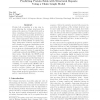294 search results - page 10 / 59 » Predicting the beta-helix fold from protein sequence data |
BMCBI
2005
13 years 7 months ago
2005
Background: Proteins carrying twin-arginine (Tat) signal peptides are exported into the periplasmic compartment or extracellular environment independently of the classical Secdepe...
ICML
2005
IEEE
14 years 8 months ago
2005
IEEE
Protein fold recognition is a key step towards inferring the tertiary structures from amino-acid sequences. Complex folds such as those consisting of interacting structural repeat...
ICASSP
2007
IEEE
14 years 1 months ago
2007
IEEE
Protein structure prediction aims to determine the three-dimensional structure of proteins form their amino acid sequences. When a protein does not have similarity (homology) to a...
BMCBI
2006
13 years 7 months ago
2006
Background: The majority of peptide bonds in proteins are found to occur in the trans conformation. However, for proline residues, a considerable fraction of Prolyl peptide bonds ...
BMCBI
2008
13 years 7 months ago
2008
Background: Prediction of disulfide bridges from protein sequences is useful for characterizing structural and functional properties of proteins. Several methods based on differen...

